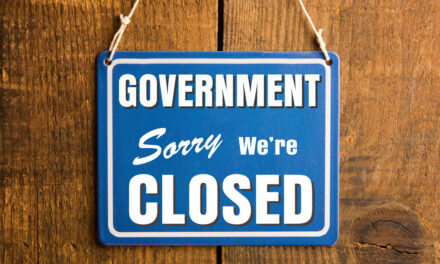It’s day 15 of the US federal government shutdown, and there’s still no real end in sight.
As I explained in last week’s Moneyball Economics, this shutdown cuts off all official data releases coming out of the US government — no scheduled reports on jobless claims, payrolls or retail spending in the near future.
But even with government going “radio silent,” we’ve still got another powerful tool for gauging the health of the economy.
And that’s earnings season…
Video transcript:
Hello, and welcome to Moneyball Economics.
I’m Andrew Zatlin, and today we’re going to talk about the latest and greatest economic data. But wait a second … two weeks into the federal shutdown, we have no economic data to chew on. We do not have consumer inflation, producer inflation, labor data. We don’t have anything. Retail data might not come out and so we’re flying blind, but in case you haven’t noticed, the market’s fairly indifferent.
Let’s talk about that indifference because what the market is assuming and continues to assume are rate cuts are on the horizon. Now, why would they assume that?
Partly because they’ve got Papa Trump out there beating up the Fed, demanding interest rate cuts, and partly because the Fed themselves are now starting to talk about some labor weakness and that’s all the markets need to know. If the Fed is already acknowledging some softness. If Trump is signaling “do interest rate cuts,” then boom, we’re off to the races.
Interest rate cuts in two weeks when the Fed meets or possibly next month doesn’t matter. We are now on an interest rate cutting trajectory, so the markets are basically sitting back. Any secondary information that comes along is going to get them interested, but by and large right now they don’t need economic data.
Having said that, they are as always going to be looking at whatever data that comes down the pipeline and trying to assess its importance and that’s why earnings season’s going to be important.
We are now two weeks into earnings season, we’re going to start hearing about consumer related companies coming out, sharing what they’re thinking, but already we’ve got some visibility from credit card companies like a MasterCard or Visa, you name it, capital One, and they’re all saying the consumer continues to spend.
And why not?
Even though Trump has been president for almost nine months, even though he came in bull in a China shop, even though he continues to rattle things up, we’ve learned that the economy moves forward and a lot of that has to do with even though we’re having these tariff issues, the core economy in the us, the domestic economy is fairly robust and consumers continue to spend their incomes, which are growing still.
Now, there are pockets of growth and pockets of weakness, and that’s what earnings season’s going to reveal to us.
Obviously, one huge pocket of growth is going to be IT (information technology) because whether you’re AI or crypto, wherever you are, all roads lead to it and to apparently a lot of electricity softness.
While AI is creating some softness, but also in general, you have a lot of people who are working not looking to retire, especially when the economy’s a little bit potentially getting rocky ish, a lot of uncertainty.
So a lot of folks who graduated with these wonderful degrees in whatever it is they graduated with that are useless, they’re now struggling to get jobs and AI is further pressing out and taking a lot of transactional jobs, a lot of entry level jobs, and removing them from the workplace. This will shake itself out because as the economy grows, it will pull along jobs.
[Spad]
Right now, expectations are kind of low in earnings season, they’re probably going to be beaten, but it, everyone’s out there looking for data and all the data is going to reinforce that things are okay, recession not happening, things are okay, but we really need some help.
Labor market needs help, for example, the housing market needs help and so on and so forth. Interest rate cuts are definitely a focal point for enabling all that in the background.
What I’d like to encourage you to think about as we wait for other economic data, remember that Trump is out there directly and indirectly trying to stimulate the economy. He’s directly trying to stimulate it. For example, by attacking the pharma industry and forcing prices down by going after taxation. So in April, a lot of households will get more money in their pocket, maybe even giving out a tariff dividend.
He’s trying to stimulate this economy directly in some short term and longer-term ways, but also indirectly he’s trying to remove a lot of regulation.
For better or worse, you remove regulation, things tend to speed up. An example of a regulation environment that doesn’t work would be California with Pacific Palisades, here we are a year later, they still haven’t been able to start building, so this is the kind of stuff that holds down an economy. If it’s done across the border on the country, Trump is trying to remove this and then accelerate and speed up demand for capital and so on and so forth.
There are other things he’s doing in the background. Again, loosening regulations on banks, enabling more credit to enter the market. Basically, the circus came in town in January with Trump, a lot of noise. A lot of people didn’t know what to make of it, but now as we go towards the end of his first year and head into his second year, I guarantee you there’s going to be a lot of stimulus to the economy.
You really want to be long the market in the meantime this month, October, there’s not a lot of data to chew over. But when I pull my own data, for example, on the labor markets, when I look at hiring by private mom and pop companies out there across the country, when I look at S&P 500 hiring, I’m relieved to see that it’s basically positive.
When I say “basically,” what I mean is the level of hiring, the pace of hiring is tilting up a little bit, and that’s what we want to see. We want to start to see some gathering strength as we go into the end of the year.
My anecdotal evidence is that companies are gearing up to hire next year, but October, November, December are not hiring periods. Why would people are going to be going on vacation? You really can’t successfully start projects at the end of the year, but they’re starting to armor up.
They’re starting to realize that under Trump, the economy will firm up year one, rocky, but year two firmer and they need to prepare for that.
This type of economic data is going to start emerging, call it green shoots, but right now it’s not coming out and that gives you an advantage because once this economic data does start to, whatever has been happening in the past few weeks will get eclipsed with the latest and greatest.
So over time, over weeks, over a couple of months, as these companies firm up as their demand for work firms up, for labor firms up, as CapEx, spending plans start to firm up, you’re going to see a lot of this demand emerge and whatever sogginess there was early October or October overall, will suddenly start to firm up and that’s where folks are going to basically focus.
We’re in it to win it.
Zatlin out.

Andrew Zatlin
Editor, Moneyball Economics





